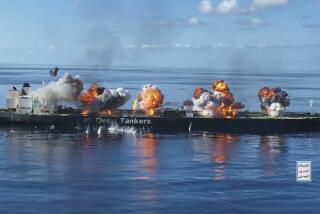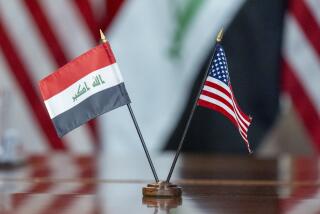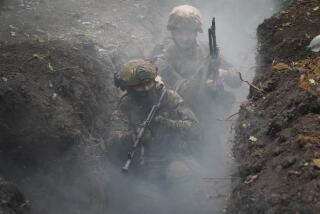Iran Missile Hits Main Kuwaiti Oil Terminal : 3 Hurt, Fire Started at Key Facility; Officials Pledge to Strengthen Defenses to Block Attacks
KUWAIT â An Iranian missile exploded Thursday on Kuwaitâs primary offshore oil-loading terminal in the Persian Gulf, touching off a fire and injuring at least three people.
The late morning attack, the third raid in a week on the Al Ahmadi terminal, raised tension sharply in the region. Kuwaitâs vital offshore oil terminal now seems prey to attack at will by Iranian missiles.
The Kuwaiti government issued a âstrong denunciationâ of the Iranian action. According to the Kuwait News Agency, the charge dâaffaires at the Iranian Embassy was called in by the Foreign Ministry and told that âthe serious attack was unwarranted and had unveiled Iranâs resolve to drag non-belligerent countries of the region into this tragic war.â
Follows Retaliation
Thursdayâs attack took place just three days after U.S. warships destroyed an Iranian oil platform in the gulf in retaliation for last weekâs Iranian missile attack against an American-registered tanker at the Kuwaiti terminal. Iran had vowed repeatedly to retaliate for the American attack.
After the missile, described by the Kuwaiti military as a Chinese-made Silkworm, slammed into the Kuwaiti terminal, Kuwaitâs defense minister, Sheik Salim al Sabah al Sabah, was quoted by the Kuwait News Agency as saying that his government was âconsidering appropriate measures to deal with this type of missile.â
A senior Kuwaiti official said later that Kuwait, which has an army of 10,000 men and a navy that consists of eight ships, was in the process of obtaining sophisticated anti-missile defenses. He gave no details but was quoted as predicting that Kuwaitâs vulnerability to attack âwould not continue.â
According to a Defense Ministry statement, the missile involved in Thursdayâs attack was launched from an Iranian position on the Faw Peninsula in southern Iraq, about 50 miles north of Kuwait. The same type of missile was used by Iran last week in attacking the American-flagged tanker Sea Isle City and the American-owned tanker Sungari, which is registered in Liberia.
One Worker Hospitalized
Of the three oil workers injured Thursday, one was hospitalized with a leg injury. The fire, which was extinguished by Kuwaiti workers, apparently involved diesel fuel that is stored on the terminal for use in pumps. The crude oil did not ignite.
The Al Ahmadi terminal is a 1,000-foot-long man-made island that is used to load crude oil into supertankers that are too large to come alongside an onshore pier.
The terminal, which lies 10 miles off the port of Al Ahmadi, is a dense complex of pipes, pumps and tanks, the heart of which is a central platform, 250 feet in length, that towers 100 feet above the ocean. It is designed so that two supertankers can load crude oil at the same time.
Loading Area Empty
The Kuwaiti oil minister, Sheik Ali al Khalifa al Sabah, said in an interview that there were no ships in the loading area at the time of the attack. He said it is believed that it was the central structure that attracted the missileâs homing radar.
He said he could not estimate how long the terminal might be out of service but indicated that it would not seriously impair Kuwaitâs ability to export. He said the terminal could account for up to 50% of Kuwaitâs petroleum exports, but that âthere are a lot of things one can do when pressed.â
The damaged terminal is used exclusively for crude oil exports, and in recent years Kuwait has diversified into exporting refined petroleum products. The refined products are loaded at terminals to the south of Thursdayâs target.
Kuwait Under OPEC Curbs
The oil minister said Kuwaitâs export capacity was 5.6 million barrels a day and that the country is required under a quota agreed to by members of the Organization of Petroleum Exporting Countries to produce no more than 960,000 barrels a day.
Although Kuwaiti officials tried to seem optimistic about the situation, foreign shippers are now considered likely to reassess the danger before sending tankers to load at Kuwait.
On Wednesday, it was announced that insurance rates paid by shipowners have risen dramatically since last weekâs attacks on the two tankers. The increased rates will not affect Kuwait directly because it writes its own insurance.
The repeated attacks are also regarded as likely to cause anxiety in the convoys of American-flagged Kuwaiti tankers that have been plying the gulf since July, when Kuwait re-registered 11 tankers in the United States in order to qualify them for protection by the U.S. Navy from Iranian attack. Iran has been targeting Kuwaiti vessels because it accuses Kuwait of supporting Iraq in the seven-year-long war.
In Washington, Pentagon officials told the Associated Press that the closest of the two U.S.-flagged Kuwaiti tankers in their home waters--the Sea Isle City and the Gas Princess--âwas 10 miles awayâ at the time of Thursdayâs attack.
U.S. officials have expressed confidence that the sophisticated weaponry aboard the U.S. warships is capable of shooting down an incoming Silkworm missile. But some officers have expressed misgivings about accompanying tankers carrying liquefied gas. One officer said a tanker carrying liquefied gas is like a âgiant floating Bic lighter.â
Kuwaiti officials said privately that they think there is little that the Reagan Administration can do about Thursdayâs attack, since the missile hit Kuwaiti territory rather than a ship.
âWeâve always maintained that protecting our territory is our responsibility no matter what the damage,â one official said.
Military delegations from the United States, France and Italy consulted with Kuwaiti officials last week, and it is believed that Kuwait was shopping for some means of neutralizing the Silkworm threat at the Faw Peninsula site.
The Silkworm, which the Chinese have used for about 20 years, is the Chinese version of an early Soviet surface-to-surface missile, and Kuwaitâs defense options include anti-aircraft missiles and anti-aircraft guns, as well as radar countermeasures to confuse the Silkwormâs guidance system, which is considered unreliable.
The Kuwaiti statement of Thursday noted that Kuwaiti soldiers stationed on Faylakah Island âsaw the Silkworm missile whiz toward the southern part of the countryâ in flight but were unable to do anything about it.
More to Read
Sign up for Essential California
The most important California stories and recommendations in your inbox every morning.
You may occasionally receive promotional content from the Los Angeles Times.









